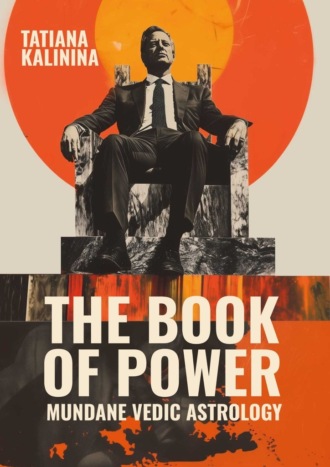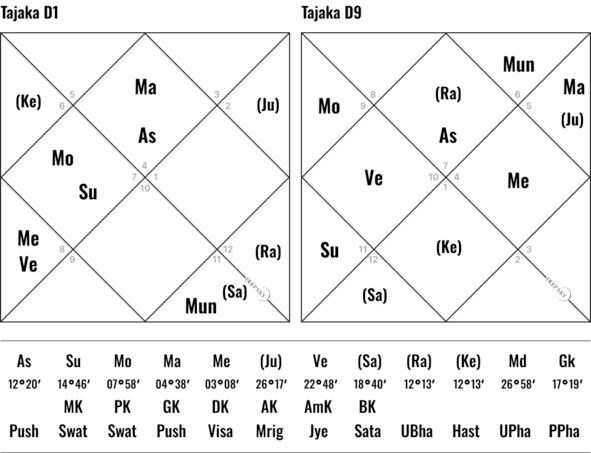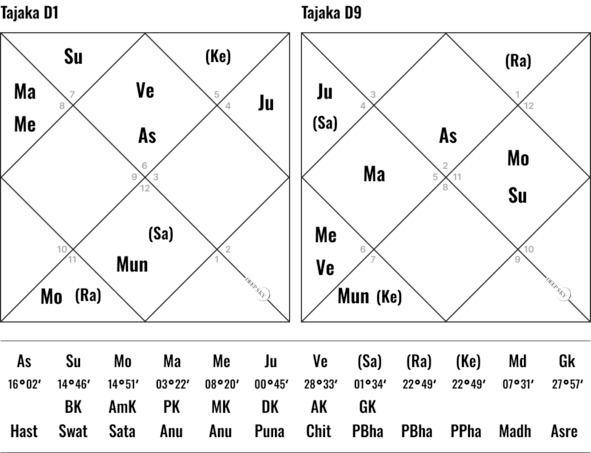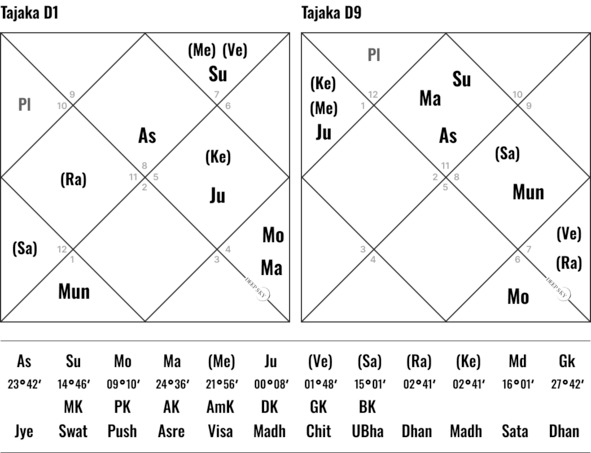
Полная версия
The Book of Power. Mundane Vedic Astrology
In charts for alliances that bring together many countries, it is actually common to see debilitated planets. You would expect the natal chart representing 27 nations to be overwhelmingly strong – but it is not.
In the EU’s chart, the Sun is at its weakest position, sitting in Libra, in the nakshatra Swati. This reflects a key idea: EU members willingly give up part of their personal authority for the sake of cooperation, unity, and mutual support.
Later in this book, you will see birth charts of authoritarian leaders, where the Sun is usually in a powerful position. By contrast, in the charts of democratic leaders and unions, the Sun is often weak which is a sign of diplomacy and a willingness to share power.
The third house, which rules borders and communication, is also weakened – Venus is in fall there. At the same time, there is a mutual exchange between the rulers of the third of borders and fourth houses of territory, which clearly shows how internal EU borders are open, while its external ones are tightly controlled.
Venus in Virgo is a perfect symbol of the EU’s rigid, detail-heavy application process, with its multiple levels of review and strict standards. The Moon, the ruler of the whole chart, is in the eleventh house of alliances, and it is exalted in Taurus – a powerful placement.
Between January 27, 1998, and January 27, 2008, twelve countries joined the EU: Estonia, Latvia, Lithuania, Poland, the Czech Republic, Slovakia, Hungary, Slovenia, Cyprus, Malta, Bulgaria, and Romania. That was the largest expansion in the EU’s history.
Let us take a look at the EU astrological chart for 2004 (technically from November 1, 2003 to November 1, 2004).
Case Study 7. Annual EU Chart: 2003—2004
Venus stands out in the D-1 chart (the main natal chart), the D-9 (which complements the main chart) and the D-4 (focused on land and territory). In all three of them, it forms a Raja Yoga – a powerful combination related to success – and in every case, it is connected to the eleventh house, the house of alliances, unions, and collective goals.

The Annual Chart of the European Union for 2003—2004
Venus naturally represents peace, unity, and cooperation. So it is no surprise that the EU’s 2004 annual chart clearly pointed to a major event: the accession of ten new member states.
We will take a closer look at how this expansion shows up in the astro charts of those countries in the next chapters.
The Moon period from 1998 to 2008 was not smooth sailing for the EU. The Moon is sitting in the eleventh house, but it is right next to Ketu, which is often associated with economic pressure, restrictions, and crisis.
During that time, the EU had to deal with two global economic shocks, while also shouldering the weight of social spending for its newest, less wealthy members. It was a tough stretch – one that really tested the Union’s resources and internal balance.
The Moon is positioned close to one of the most malefic stars in the sky which is Algol, located in the constellation of Perseus.
Algol is traditionally associated with retribution, legal prosecution, and downfall. As soon as the Moon period began, there was a collective resignation of the head of the European Commission, Jacques Santer, and the 19 remaining members following allegations of fraud.
It is remarkable how consistently Algol shows up in national astrological charts – almost always signaling trials, persecution, and the downfall of prominent figures.
The Mars period, which ran from January 27, 2008 to January 27, 2015, saw an attempt to establish a common European constitution. But that effort ultimately stalled, as it was not ratified by all EU members.
The idea of a shared constitution was first launched at the EU summit in December 2001, during the Moon – Jupiter period. Jupiter, being the ruler of the ninth house of law, diplomacy, and foreign policy, and a natural significator of legal matters, made this initiative a predictable outcome of that alignment.
Maha Dasha of Jupiter begins in January 2033, and it is very likely that this will mark the formal adoption of a pan-European constitution.
For the first time, banknotes and coins of the new Euro currency were introduced into circulation on January 1, 2002. At that time, the EU was in the Moon – Jupiter period. Jupiter as part of a Raja Yoga involving the rulers of the second house of money and the ninth house.
It is likely the launch did not take place during the Sun period, because the Sun is debilitated in the chart. But a successful and strong neighbor helped the ruler of the house of money and manifested a common currency for all allied countries.
In the D-9 chart, Jupiter is also the ruler of both the second and eleventh houses, once again linking money and alliances.
Mars holds a particularly telling position in the EU’s chart. Since the Union is a collection of territories acting as one, Mars as the natural indicator of land and property is strong and functions as the Raja Yoga Karaka.
It is placed in the fifth house, which governs colonies, extensions, and subsidiary lands. This placement clearly shows that the EU is, among other things, a territorial association.
Mars as the Raja Yoga Karaka is also a recurring feature in the astro charts of countries that have joined the EU. It reflects their potential to become part of a larger territorial structure and to benefit from EU membership, especially through freedom of movement within the expanded territory.
Mars as the Raja Yoga Karaka often appears in the annual charts of countries during the year they join the European Union.
The Rahu Maha Dasha, which began on January 28, 2015, set the tone for the EU’s development over the next 18 years. It clearly points to a future where Europe is filled with foreigners and outsiders.
Already in the fall of 2015, the EU faced a migration crisis, triggered by a dramatic rise in the number of refugees and undocumented migrants entering the Union.
Rahu is also positioned next to the star Bungula, part of the Centaurus constellation. Stars like this are part of a new branch of astrology, which you can read more about in the book Deep Sky Astrology.
Bungula is a star associated with sudden and unexpected breaks in relationships. Right as the Rahu period began, the United Kingdom voted to leave the EU, and by the end of the first sub-period of Rahu – Rahu in January 2020 Brexit was finalized. The UK became the first country to exit the European Union after 47 years of membership.
These two themes – a growing influx of migrants and the sudden rupture of long-standing partnerships – will likely remain relevant throughout the entire Rahu period, lasting until at least January 2033.
It is also fascinating to see how the COVID-19 pandemic shows up in the EU’s natal chart. The Union entered a Rahu – Saturn period on March 4, 2020, just 12 days before a full lockdown was imposed across Europe.
In this chart, Saturn is the ruler of the eighth house, the house of crisis, trauma, and upheaval. It is placed in the seventh house, disrupting peace and balance in the country.
Saturn in this chart is stationary – it had just stopped before turning direct. This occurred on October 28, 1993, just three days before the Maastricht Treaty came into effect. It takes Saturn about three days to return to its normal speed, meaning that at midnight on November 1, the moment the EU was officially formed, Saturn was essentially motionless.
During Saturn’s sub-period, we saw the visible world in the Eurozone come to a standstill – empty streets, no crowds in cafes or restaurants, no traffic during rush hour. The lockdown froze life in Europe for many long months.
The seventh house in a country’s astrological charts reflects both peace and disturbances of peace within the nation. In this case, Saturn revealed itself through military involvement in managing the epidemic – military field hospitals, curfews, city control, and the enforcement of citizen isolation.
I have noticed that in the natal charts of developed countries, damage to the seventh house tends to manifest in a milder form, as it did here. But in the third world countries any affliction to the seventh house often leads to military escalation, revolutions, or other severe crises.
The more developed a country is, the less vulnerable it is to military catastrophes. This is something astrologer-forecasters must consider – and they should look for alternative causes of unrest when interpreting the seventh house in such charts.
For example, we now know for sure that when Ketu influences a country through the Vimshottari Dasha, and there is disturbing the peace in their astro charts through the damage of the seventh house, this can point to epidemics, national isolation, and attempts to maintain control through military measures.
Likewise, malefic influences on the third house do not always indicate conflict with neighboring countries. They may also reflect situations such as border closures or the suspension of civilian movement, especially in the context of epidemics or sanctions.
Predictions for the European Union
The European Union is currently in a Rahu – Mercury period, which lasts from January 11, 2023, to July 31, 2025. Mercury is retrograde, and in this context, it reflects the state of the EU’s energy resources, which are limited at this time. Why? The answer lies in Mercury’s placement in the nakshatra Vishakha.
The deity presiding over Vishakha Nakshatra is Indra, king of the gods, who also rules Jyeshtha. Vishakha, under Indra’s influence, carries a subtle sense of pride and seniority, which can make individuals or nations influenced by it feel superior and act accordingly. Yet at its core, Vishakha remains peaceful and inclined toward reconciliation between opposing sides.
Vishakha is also associated with sanctions. Its ruling planet, Jupiter, governs the sixth house (sanctions and legal disputes) as well as the ninth house (diplomacy and jurisprudence) in this chart. As a result, Mercury is weakening because of the indicators of both of these houses.
From July 31, 2025, to August 19, 2026, the EU enters a Rahu – Ketu period. Ketu is located in the eleventh house of Parliament, which will bring meaningful changes to the European Parliament, despite the fact that elections have already been held in 2024 and this convocation has been approved until 2029.
Ketu represents separation, disconnection, and reduction. In the eleventh house of alliances and unions, its influence can signal tension or a breakdown in cooperation with one or more allies.
Ketu is placed in the nakshatra Krittika – a solar nakshatra associated with separation and cutting away. Its symbol is a blade, a knife. The core idea behind Krittika is to cut off what no longer serves a purpose, to strip away the unnecessary, and to complete unfinished work by clearing out what is in the way. Krittika burns through anything that will not be used.
That is why I would not be surprised if, during the Ketu period from July 2025 to August 2026, the EU begins shedding excess – cutting budgets, reducing salaries and bonuses, and trimming back wherever it can.
And most important – from the summer of 2025 the EU will be threatened by the prospect of economic crisis and lack of resources, because Ketu stands in the house of savings and wealth. The same downward trends will apply to relationships with partners, spending on alliances, partnerships, and the like.
If we turn to the EU’s annual chart for the period from October 31, 2024, to October 31, 2025, here is what we find.
Case Study 8. Annual EU Chart: 2024—2025
In the EU’s annual chart, Saturn is conjunct with the star Hydor, which lies in the stream of Aquarius. This alignment may signal the possibility of water-related disasters affecting EU territory.
The Muntha is positioned in the eighth house of crisis, indicating a stressful and turbulent year. That house is heavily afflicted by both Saturn and Mars. That means, in 2025, the changes in the EU are going to be very significant and dramatic indeed.
One of the year’s most striking features is Mars in fall, placed in the first house, while also being the ruler of the tenth house of power and governance.
Based on this position, I believe that EU leadership may be compromised in 2025, triggering talks of re-election or leadership reshuffling.

The Annual Chart of the European Union for 2024—2025
On February 23, 2025, Germany, the EU’s leading country, will hold a snap election for chancellor… In this case this chart omen concerns the change of political course of Germany within the European Union.
Mars in this placement also emphasizes issues related to military affairs and armaments, likely bringing disputes, disagreements, and tensions across the Union. The maximum scenario of how Mars can harm the EU in 2025 is a dramatic change of leading personas in the union.
Additionally, Mars rules the fifth house, which relates to culture, sports, the arts, and intellectuals. This suggests that the events of 2025 may negatively impact these sectors as well.
The ruler of the second house of finance is also in fall, which indicates that 2025 will be a financially weak year for the EU.
Unfortunately, the outlook in the annual charts for the following years does not appear much more optimistic.
Next, let us look at the annual chart covering the period from November 1, 2025, to November 1, 2026.
Case Study 9. Annual EU Chart: 2025—2026
We can see two debilitated planets that are related to the second house, the house of finance, which indicates that the financial condition of European countries will be weaker than usual during this year.
At the same time, Jupiter is exalted in the eleventh house of alliances, suggesting a warming of relations with partners and pointing to the possibility of a new alliance or a new candidate for EU membership.
Mars and Mercury are both strongly placed in the third house, but they occupy a specific zone known as Sarpa Drekkana – a degree linked to restriction and control. This has a direct connection to sanctions, meaning that in 2026, EU trade and economic activity will still be heavily constrained and affected by sanction regimes.

The Annual Chart of the European Union for 2025—2026
Case Study 10. Annual EU Chart: 2026—2027
In 2027 (according to the EU’s annual chart from November 1, 2026, to November 1, 2027), the ruler of the first house, Mars, is in fall and placed in the ninth house of diplomacy. This again points to international tension, sanctions, and potential conflicts, along with signs of aggression.
One particularly interesting factor in this chart is the opposition between Pluto and the Moon along the 3—9 house axis. Pluto is a symbol of conflict and upheaval, while the Moon represents the well-being and everyday life of the population.
In this year, Jupiter’s favorable position will provide additional funding. Positioned in the tenth house of power, near the royal star Regulus, Jupiter highlights the EU’s prominence on the global stage and reinforces its influence in international politics.

The Annual Chart of the European Union for 2026—2027
The EU’s diplomatic success is further supported by the placement of Venus, Mercury, and the Sun in the twelfth house, which governs foreign affairs and international engagement.
Venus is placed close to Arcturus, in the constellation of Boötes, Mercury is close to Zubenelgenubi or the Southern Claw. Both stars are very favorable, speaking of success and leadership.
When we analyze the natal chart of unions or associations, we operate on the level of ideas and values. At this level, nakshatras become especially meaningful, offering rich, symbolic insight into the events unfolding within these large-scale structures.
Moreover, understanding that, in such astrological charts, we are dealing with long-term trends stretched out over time.
It is no secret that the smaller the living organism, the faster its metabolism and the shorter its lifespan – a bacterium lives hours, a mouse lives a few years, while an elephant may live 60 to 70 years.
By the same principle, the larger the state or alliance, the slower its inner processes unfold. These dynamics accumulate gradually, often culminating in a defining moment or historical event.
The Maha Dasha (period) of planets or signs shows the general direction and development of these long-term trends, while the Antar Dasha (sub-period) marks the moment those trends break through and become visible on the surface of history.
Nation’s Charts. Germany
The astrological chart of Germany is strikingly similar to the natal chart of the European Union. It often happens that the chart of a creation mirrors that of its creator.
In my personal collection of astrological data, I have gathered three astrological charts for Germany, each of which deserves special attention in its own right.
The first natal chart covers the period from August 14, 1919, through 1933.
This phase begins with the enactment of the Weimar Constitution and continues up to Hitler’s inauguration, which marked the beginning of a new chapter in German history – Nazi Germany.
Case Study 11. Natal Chart of Germany
The position of Saturn in Leo is particularly noteworthy – the German Socialist Republic was proclaimed following the fall of the King of Prussia, the result of an anti-monarchist uprising. Saturn’s placement in Leo, the sign of kingship and authority, reflects the restriction and dismantling of the ruling class.
Let us see how brilliantly the chart shows the power structure in this country.
The legislative branch (eleventh house) was represented by two bodies: the Reichsrat (Imperial Council), composed of delegates from the state governments, and the Reichstag, elected by citizens through universal, equal, and direct suffrage by secret ballot.
The head of state (tenth house) was the Reichspräsident, elected by the people.

The Natal Chart of Germany
Executive power rested with the Reichsregierung (Imperial Government), made up of the Reich Chancellor (Reichskanzler) and Imperial Ministers (Reichsminister). The President of Germany (Reichspräsident) appointed the government (tenth house), but it was accountable to the Reichstag (eleventh house).
So, how is this seen in the chart? The Reichstag is obviously the eleventh house, as it serves as parliament. In the chart it is ruled by a strong, exalted Jupiter in the third house – an ideal placement for a legislative body. Jupiter is powerful, though it sits next to hostile Mars, hinting at military coups that threaten the republican idea of the state.
In the end, this is exactly what unfolds: a military coup brings a totalitarian leader to power, one who would turn the world upside down in 1939.
The ruler of the tenth house representing the Reich Chancellor and his Ministers is Saturn which greatly limits the powers of the executive. Saturn is placed in the house of opposition, suggesting protests and resistance. In any case, Saturn’s influence over the tenth house imposes strict limits on the executive power.
However, Saturn is also a Raja Yoga Karaka, and in the second half of the republic’s life, this will give the executive more strength.
Mercury. The country entered the Jupiter – Mercury period, marking a kind of “restart.” Mercury, located near Saturn, indicates continued civil unrest and protest. It also reflects separatist tendencies, since Mercury rules the fifth house of disputed and subsidiary territories and is afflicted by Saturn.
On January 10, 1919, the Bremen Soviet Republic was declared, only to be dissolved shortly after by troops from Berlin. A little later, the Bavarian Republic also shared the fate of the Bremen Republic.
During the Mercury period, the Treaty of Versailles was signed, resulting in Germany losing territories and colonies, and being forced to pay reparations.
Also under Mercury, a referendum was held on July 11, 1920, after which the districts of Allenstein and Marienwerder remained part of Prussia. Mercury is conjunct Saturn, ruler of the ninth house, which is a classic indicator of a popular vote.
More broadly, the German Socialist Republic experienced major territorial shifts between 1918 and 1921, consistent with Mercury’s position in the fourth house (land and territory) near restrictive Saturn.
Mercury is retrograde and sits at the very beginning of its sign, meaning it has not yet gained full strength – this contributes to the difficulties the country experienced under this period.
Ketu. Mercury’s period was followed by Ketu’s period in the first house of prosperity of the entire nation. Ketu indicates sanctions and exclusion.
It is important to remember: when Ketu appears in the first house of a politician’s chart, it often signals persecution, loss of civil rights, and pariah status. The same effect can be observed at the national level, which is exactly what the astro chart revealed in this case.
Venus. Now, let us turn to Venus, which is in fall – a major and recurring feature of German astrological charts.
In a nation’s chart, Venus governs the arts, social policy, and justice. When well-placed, Venus brings cultural richness, fairness in governance, artistic achievement, and a higher quality of life.
A strong Venus in annual charts often signals peace treaties or ceasefires. When Venus and Jupiter – two benefic planets – are coming together, they have the power to halt wars.
On the other hand, a debilitated Venus often corresponds with currency devaluation (as was the case when the German mark was eventually abolished with the introduction of the euro), collapsed peace agreements, worsening social programs, or imbalanced governance.
In the birth charts of rulers, a weakened Venus is often a sign of cruelty and political terror.
Конец ознакомительного фрагмента.
Текст предоставлен ООО «Литрес».
Прочитайте эту книгу целиком, купив полную легальную версию на Литрес.
Безопасно оплатить книгу можно банковской картой Visa, MasterCard, Maestro, со счета мобильного телефона, с платежного терминала, в салоне МТС или Связной, через PayPal, WebMoney, Яндекс.Деньги, QIWI Кошелек, бонусными картами или другим удобным Вам способом.




